Operation Oyster
| Operation Oyster | |||||||
|---|---|---|---|---|---|---|---|
| Part of the Second World War | |||||||
 Bostons fly past the burning Philips Emmasingel plant during the Eindhoven raid | |||||||
| |||||||
| Belligerents | |||||||
|
|
| ||||||
| Commanders and leaders | |||||||
|
| |||||||
| Strength | |||||||
|
93 light bombers 47 Venturas 36 Bostons 10 Mosquitos | |||||||
| Casualties and losses | |||||||
|
62 aircrew 15 aircraft lost 57 damaged | 1 FW 190 (against a diversion) | ||||||
| Philips Works suffered significant damage. | |||||||
Operation Oyster was a bombing raid made by the Royal Air Force (RAF) on 6 December 1942 upon the Philips Works at Eindhoven, Netherlands. The Philips company was a major producer of electronics equipment, including vacuum tubes for radio communication. Prior to the Battle of the Netherlands in 1940, Philips was known to be a leading research firm in infrared and radar technology. To insure accuracy and minimize casualties among the Dutch citizens, the raid had to be undertaken during the day. Being beyond the range of the fighter escort, the four engine bombers that made up the bulk of Bomber Command were considered unlikely to survive the mission. The medium bombers of 2 Group were given the task of delivering the bombs. To improve their chance of survival, diversionary raids were put on to draw away the German defenses. Almost all of 2 Group was committed to the raid and it was the largest and most successful 2 Group operation of the war.
Background
Philips, Eindhoven
In April 1942 the Air Ministry, in consultation with the Ministry of Economic Warfare, produced a list of the highest value targets in the occupied countries. A list of eight targets within range of the RAF was established.[1] Of these, the Philips radio and vacuum tube factory in Eindhoven was the priority.[2] Philips was a leading firm in electronics. The firm was a major employer in Eindhoven, where production was performed at the massive Strijp works, and the smaller Emmasingel works a half a mile away to the southeast.[3] Prior to the war Philips made major advances in the design and production of vacuum tubes. It was known to have some of the best research scientists in the world. An appraisal by the Air Ministry estimated that the plants in Eindhoven produced a third of the radio tubes used in German military equipment. It was feared that the firm was being used to perform research into electronic counter-measures and radar technology.[3] A first category target, the Philips works was considered as important as any target in Germany.[1]
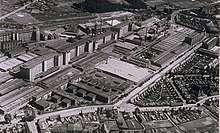
The location of the Philips works in the middle of a major Dutch city precluded Bomber Command from putting on a large scale raid at night, as this would result in a great many civilian casualties.[4] To limit loss to the civilian population and ensure accurate delivery of the bombs the target would have to be attacked during the day.[5] 70 miles (110 km) inland from the coast, it was beyond the range of fighter escort. Using Lancasters was considered and rejected, as their losses would be too high flying through the middle of a German fighter belt. Mosquitos were considered as well but the Philips works were too large for the number of Mosquitos available.[2]
2 Group
No. 2 Group RAF was the sole day bomber group of Bomber Command and consisted of ten medium bomber squadrons stationed on airfields in Norfolk. The group flew with Fighter Command in operations against the Luftwaffe. Daylight raids with small formations attacked the coastline, shipping and targets in northern France. Their raids were flown at medium altitudes through the German fighter defenses, but the two large Philips plants in Eindhoven could not be destroyed by the typical twelve-aircraft formation used in Circus raids. Bomber Command elected to commit all ten squadrons of 2 Group to the raid. This meant four bomber types, the Lockheed Ventura, Douglas A-20 Boston, North American B-25 Mitchell and de Havilland Mosquito would participate, each with their own performance characteristics. It was the most ambitious raid ever put on by 2 Group. Approval for the raid was given on 9 November 1942 as Operation Oyster.[3][6][5]
Prelude
Training

The first full scale practice was held on 17 November.[7] The Ventura crews soon learned that the backwash off the paddled blades of the other Venturas made their planes liable to skid and difficult to control; flying so low left no time for recovery. Any mistake and you could end up in the north sea or into the ground.[8] You had to be very attentive to stay on station. The pilot had to focus on the wing or tail of the aircraft before him. The lead pilot had to be cognizant of the trailing aircraft, accounting for his position with each maneuver he made.[9] Flying low over Holland the pilots and navigators would have to keep a sharp eye out for obstructions. An additional risk of low level flying was bird strikes. Birds on the coast tended to be larger, and when startled by the noise of an aircraft engine they would take off into the air. The risk of bird strikes was one of 2 Group's greatest dangers.[9]
The initial plan was for the Venturas to attack first, followed by Bostons at one target and Mitchells and Mosquitos at the other. All aircraft would fly at low level until right before the target, when they would climb to 1,500 feet to allow a shallow dive attack.[10] Performance was poor on the first trial. Aircraft were arriving over the target from different directions and off the timeline. The Venturas, in particular, arrived over the target in a ragged fashion. It was apparent that time was needed for the aircraft to form up into groups by type. It was also apparent the Mitchell crews were simply not ready to fly a raid this demanding in air discipline. Lastly, it was realized that if the Venturas went in first carrying incendiaries the smoke from the fires they set would greatly obscure the target for the following aircraft.[11]

A number of adjustments were made following the initial training flight. The biggest change was the order of the attacking aircraft, putting the Bostons over the target first, followed by the Mitchells and Mosquitos, with the Venturas arriving last. Take-off times were also pushed forward to allow the aircraft more time to orbit and form up. A second trial run was put on by the Venturas alone the next day, 18 November. This went much sharper. Between exercises crews practiced bombing at low level, bombing at 1,000 feet, bombing at 1,500 feet and all manner of formation flying in pairs and combinations of three pairs.[12] A third trial run with all forces on 20 November was considered a definite improvement.[10] Nevertheless, the two Mitchell squadrons, 98 and 180, were removed from the raid roster.[10] Their crews were still working up, and they did not possess the skill to pull off the raid.[13] This brought the force down to 8 squadrons.
Plan
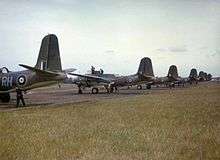
The order for the attack and initial plan were issued 17 November 1942.[14] Training for the raid began immediately. Wing Commander James Pelly-Fry of 88 Squadron was made the commanding officer of the attack.[2] He was an experienced pilot who had flown in Africa and been in command of 88 Squadron since the start of the year.[15] Pelly was to fly one of the two low level lead Bostons against the Emmasingel factory, and would be the first man to the target.[16] Circus raids by 2 Group involved from six to 30 bombers, flying at medium altitudes and rendezvousing with their fighter escorts on the way. To strike with the element of surprise, the Eindhoven raid was to be flown at low level from start to finish. Low level flight would avoid radar detection, limit the exposure to anti-aircraft fire and make it more difficult for German fighters to attack.[14]
None of the crews had experience flying a mission in such a large formation, nor so low to the ground. The four types of bombers being used had different ranges and different top speeds. To overwhelm the defences at the target and thereby minimize losses it was planned that all aircraft would be over the target, deliver their bombs and be gone in ten minutes time. This would require careful planning. The Venturas were the slowest, the Bostons and Mitchells intermediate, and the Mosquitos the fastest.[9] The mission profile was set to the limits of the Venturas, which were nearing the limit of their range over Eindhoven.[17] The aircraft were to fly in pairs, in company echelon to starboard. As many as 6 aircraft could be grouped together, but no more as formation flying was awkward and made it difficult for any kind of maneuver. The big problem was getting a large group of aircraft to arrive at precise times.[18] Formation flying was not new to the group but large formation flying at tree top level was. The attacking force was made up of 48 Venturas from 21 Squadron, 464 (Australian) Squadron and 487 (New Zealand) Squadron, 36 Bostons from 88 Squadron, 107 Squadron and 226 Squadron and ten Mosquitos from 105 and 139 Squadrons.[2]

Though different air speed ranges were assigned to the aircraft based on type, all aircraft were to approach, attack and leave the target at maximum speed.[19] A force of 12 Bostons, 10 Mosquitos and 31 Venturas were to strike the main target at the Strijp Group works. At the same time 24 of Bostons and 17 Venturas were to attack the Emmasingel radio tube factory a half a mile southeast of the main complex.[20] The Boston and Mosquito bombers would carry four 500 lb (230 kg) high explosive bombs, fused with short delays of 0.025 seconds to minimize the tendency for the bombs to slide away from the target prior to detonation.[21] Once the aircraft had released their bombs they were to get down on the deck and leave at the highest possible speed. It was decided after the third trial that a Boston from each squadron would fly at low level all the way in. It was hoped that these low flying leaders would keep the attention of the flak gunners down, so they might miss the larger force that was climbing up to 1,500 feet behind them. Their four 500 lb (230 kg) bombs would be fitted with 11 second delay fuses to allow the aircraft time to get away from the target before their bombs went off. The Venturas following them were carrying a stack of 40 thirty pound incendiary bombs and two 250 lb (110 kg) high explosive bombs. The incendiaries were phosphorus, which would stick to whatever they struck and burn.[22] The two 250 lb (110 kg) high explosive bombs on the Venturas had either 30 or 60 minute delay fuses, to hamper or injure the firefighters and rescue workers.[23]
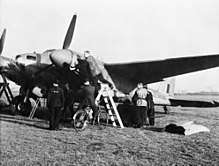
The Mosquitos would follow the Bostons on the same route, while the Venturas were to fly slightly farther to the south before turning towards Eindhoven. The three groups were to arrive over the target in close succession.[21] The attack was to be concluded within the span of 10 minutes.[6] The Bostons were to release bombs at Zero hour, which was set for 12:30 pm. They were to be followed by the Mosquitos at Zero plus 2 minutes and the Venturas would drop their bombs and incendiaries at Zero plus 6 minutes.[19] To exit, the Venturas were to fly directly west after they completed their bombing. The Bostons were to fly to the north for two miles and then turn west, so that both groups would arrive over the coast at about the same time. The Mosquitos were generally to fly north initially, but were not bound to the other aircraft for the return trip.[24]
Spitfires from 12 Group were tasked with providing Withdrawal Fighter Support for 2 Group, picking up the bombers at the coast and covering their return from the Netherlands. They were given allowance to meet the bombers as far as 5 mi (8.0 km) inland.[25] Further efforts to protect the bombers involved diversionary raids by the USAAF, with a formation of Consolidated B-24 Liberator heavy bombers sent to the German airbase at Abbeville, and a larger formation of Boeing B-17 Flying Fortress heavy bombers sent to Lille, with Spitfire escorts.[21] Eight P-51 Mustangs were sent on a Rhubarb or low level strafing attack.[26] On the evening of Wednesday, 2 December, the crews were briefed on the raid. Once briefed no-one was allowed to enter or leave the air bases, no mail was allowed out and the telephones were guarded.[27] The next morning, Thursday 3 December, the RAF Meteorological office declared weather conditions were unsuitable. The stations remained closed as the crews waited for the weather to improve. Finally on Sunday 6 December the weather over Eindhoven was declared favourable.[28]
Raid
Diversionary raids

The day started with the Eighth Air Force launching its diversionary raid with two major arms. A force of 19 B-24s from the 44th Bomb Group were sent out at 9:30 am to attack the German airfield at Abbeville. An hour later the primary effort of 66 B-17s from the 91st, 303rd and 305th Bomb Groups were aloft to bomb the Atelier d'Hellemmes rail yard at Lille. This was a return trip for the Eighth, who had paid a visit to the rail works a month earlier on 8 November. While these operations were running, the Eighth flew two mock runs over the channel with replacement crews to distract from their main efforts. Thus the Eighth was running diversions for their diversions. Eighth Air Force actions gave the strong appearance of standard behavior.[29]
The US bomber groups were detected and followed by German air controllers. Luftwaffe fighter aircraft from JG-1, JG-26 and JG-2 were sent up to interdict them. En route to Abbeville the B-24s of the 44th were recalled but one flight of six aircraft did not receive the recall message and proceeded on the mission. This flight was intercepted over the target and lost one of their B-24s but they reached the airfield, dropping their bombs at 11:24 am.[30] Thirty-five minutes later the main force of B-17s rendezvoused with their Spitfire escorts, arrived over Lille and bombed the rail works at 12:10 pm.[31] 37 of their aircraft were considered effective on target. As they were exiting the target area they were attacked by some 20 to 30 enemy aircraft, losing one of their number.[29]
Approach
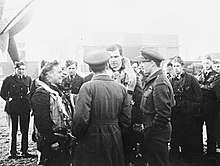
From 11:15 to 11:30 the eight squadrons of 2 Group became airborne over the Norfolk countryside. Keeping all aircraft below 100 feet and operating in strict radio silence, they formed up by type and headed out to the coast. The Southwold Lighthouse served as a guide for the Bostons and Mosquitos, while the Venturas were plotted slightly to the south, heading out over Orfordness Lighthouse. Undetected by German radar controllers, three waves of aircraft in short succession left the lighthouses behind them and headed out over the sea.[32] The raiders kept low over the North Sea, so low their prop wash could be seen on the water below them.[26] In 45 minutes the Dutch coast arose, appearing as a thin smudge upon the horizon.[33] There were no large features to guide their approach. Landfall was intended to be at a small town called Colijnsplaat, at the mouth of the Oosterschelde estuary. The town sits on the north coast of the island Beveland. The leading Bostons hit the inlet direct on. German flak batteries positioned along the coastline were taken by surprise, and were only able to put up a thin fire as the Bostons passed by.[34]
The Bostons followed their track up the Oosterschelde estuary, hugging the north coast for 30 miles to reach their main landfall at Bergen op Zoom. In the estuary, the first major hazard arose in the form of sea birds, which were startled by the sound of the aircraft approaching and rose into the air. This had been a known hazard, but the number and size of the birds was greater than anticipated. As the aircraft flew through them, some birds shattered wind screens, some penetrated cockpits and injured aircrew, others bent fuel pipes and caused wing damage. In one aircraft two gulls smashed through the nose Perspex, striking the navigator in the legs. The wind caught his maps and sucked them out the broken windscreen. The rest of the trip he was forced to navigate from memory.[35]
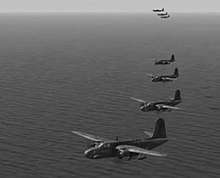
Following three minutes behind were the Venturas. Alerted by the passage of the Bostons, the German gunners were ready when the Venturas arrived. Worse, the Venturas had missed their landfall. They did not miss by much, but a small miss can make a big difference. They came in a mile to the south over the island of Walcheren.[36] German flak defenses were concentrated along the coastline, and had been placed in considerably greater depth on Walcheren.[36] Tracer fire laced out and the sea seemed to churn white below them.[37] A tremendous splash threw water up into the air as a Ventura was struck and crashed into the sea.[38] A few moments later a second took hits on the right side of the cockpit. The pilot was knocked about but was able to put the smoking aircraft down in a ploughed up field. The crew climbed out to see their squadron mates fly past. The war was over for them.[39] A few of the fighters from II Gruppe of JG-1 were just returning from the air battle over Lille when they came across the low flying bombers. Rudolph Rauhaus brought his Focke-Wulf 190 in behind a Ventura as it cleared Walcheren and caught it with a burst from his guns. Damaged, the aircraft crash landed on the Zealand peninsula Reimerswaal. Three survived and were taken prisoner.[40]
As the aircraft approached the top of the estuary they came within site of the Woensdrecht airfield, the home of II Gruppe, just to the south of Bergen op Zoom.[26] As they flew past it German Focke-Wulfs could be seen taking off from the airfield, banking and turning towards them.[41] Mosquito pilot Charles Patterson commented,
They looked so normal, just like Spitfires taking off in England, that it was hard to realize they were coming up to kill you."[42]
Hugging the ground, the aircraft continued on a southeast course into Belgium, sliding and weaving as they went. They kept low, rising up slightly to help clear hedges and houses. Pilots worked with their navigators, each pointing out trees, chimneys, high-tension cables and other obstructions to avoid.[43]
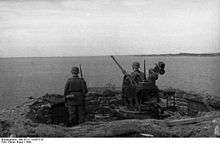
Following the Bostons, the pilots in the Mosquitos observed enemy aircraft approaching from the airfield. Squadron Leader D. Parry and Flight Lieutenant W. Blessing turned toward them.[44] They closed in a moment and soon were being fired upon. Banking and pushing throttles full on, they accelerated.[45] The Focke-Wulf 190 had a performance advantage over the Spitfire V, with a top level speed about 20 mph faster, but then this was also true of the Mosquito. Between the two aircraft, which was faster was a near run thing.[lower-alpha 1] Parry went flat out, keeping an eye on his pursuers. Eluding his attackers, he was able to rejoin the attack. Blessing, on the other hand, was chased for ten minutes. He was able to get away but was too late to resume the mission and returned to base with his bombs.[46]
Pelly led the Bostons and trailing Mosquitos toward Turnhout. Flying at high speed and very low altitude was a navigational nightmare. If his line was wrong and he failed to lead them in to the target, coming around again would be a disaster. Reaching Turnhout he turned northeast to fly the 24 miles that would bring his squadron to Eindhoven. On the mission maps Pelly had noticed a rail line running in to Eindhoven from the south. He was desperate to find it.[43] To his great relief, arising in the distance in front of him he saw a puff of white smoke, the telltale sign of a railway engine. Coming up he stayed to the left of the raised embankment of the rail line.[47] As they reached Eindhoven two sets of very large factory buildings loomed up before them.[26] The 24 Bostons from 88 and 226 Squadrons headed for Emmasingel.[16] Splitting off to the left, the 12 Bostons from 107 Squadron followed Squadron Leader R.J. McLachlan for the big buildings at Strijp.[16]
Attack

Behind them was the Mosquito group, due to arrive on target at Zero plus 2. They had to be careful to check their speed to avoid overtaking the Bostons. Behind these came the Venturas, who had taken a slightly longer route to Oostmalle to stretch the time before turning toward Eindhoven. They would stay on the deck and deliver their incendiaries upon the factory rooftops.[48] Pelly-Fry and his wingman led 88 and 226 Squadrons in to the Emmasingel works. Their aircraft came under fire from German anti-aircraft and machine-guns mounted on the roofs of the buildings. They returned fire with their own machine-guns. Behind them, their squadron mates climbed to 1,500 feet to get ready for their shallow dive attack. Pelly came up on the factory and delivered his bomb load, but as he cleared overhead his aircraft was hit hard in the starboard engine and wing. The wing dropped and he found he was flying the aircraft at a 90 degree vertical from the ground. Struggling to regain control, he was slowly able to get his wings level. Pelly stated the aircraft felt very sluggish, and he had a hard time bringing it to port. While the time delay fuses ran down, he left the area with full power on, heading north.

It had been a quiet Sunday afternoon in Eindhoven; no air raid sirens had been sounded. The day before had been St. Nicolas Day and families were sitting down to lunch. The first sign that something was amiss was the steady humming sound of synchronized engines growing steadily louder, a telltale sign of approaching British aircraft.[lower-alpha 2] People began to come out to see what was happening. In a moment the loud firing of German anti-aircraft guns shattered the peace, soon answered by the machine guns of the approaching British bombers. Those near the factory were soon scrambling back inside their homes, as bombs began exploding behind them.[50] The Bostons of 88 and 226 Squadrons had climbed to 1,500 feet. Pilot Jack Peppiatt of 88 Squadron confessed he felt extremely vulnerable up there.[51] Leveling off, they dropped into a shallow dive and released their bombs, each aircraft delivering their four 500 pound bombs between 12:30 and 12:33. The attack was concentrated into a very short window of time. The factory shook and smoke began to fill the air.
A similar attack was carried out by the Bostons of 107 Squadron against the Strijp works. Jarred by the explosions, the Strijp tower clock stopped at 12:32. It remained stuck there, at 12:32, for the rest of the war.[52] With bombs gone, the Bostons dropped to the deck and followed Pelly-Fry, who was heading north. This had been the plan, but only for a couple of miles. Then they were to turn west for the coast. Strangely, Pelly-Fry continued heading north. The Bostons followed him. Behind the Bostons came the Mosquitos, who were working to avoid overtaking them. Due to arrive on target just after the Bostons, they also climbed to 1,500 feet. As they were climbing to bombing height they were attacked by a group of three Focke Wulfs. The Mosquito was the one aircraft in the raid that carried no armament. One of the Mosquitos turned away to run, and was chased by the German fighters. Going flat out he was able to avoid taking any damage, while pulling the German fighters away from the slower Bostons. The remaining Mosquitos dropped their bombs on the Strijp works, dropped to the deck and looked for a way out.
Following both groups were the Venturas, carrying their incendiaries in for a low level attack at Zero plus 6. As they came up behind the initial attack, there was no problem finding the direction to the target, as smoke billowed into the air. However, flying through that environment and delivering their bombs on target was another matter. The smoke obscurred the buildings and made it difficult to avoid obstructions. As the Venturas began releasing their incendiaries the fires accelerated, and it was increasingly hard to see. A number of pilots strained to get their aircraft up over the structures.[53] One of the Venturas attacking the Strijp complex took a hit and flew into a cloud of smoke. In the darkness it flew straight into a building and exploded.[54] Fire, smoke and bombing aircraft filled the air. Another Ventura was seen to get hit, catch fire and fly straight through a Dutch house, erupting in a fiery explosion as it came out the other side. Another was seen by a following aircraft to deliver its incendiaries, only to have some of the phosphorus splatter onto its tail and set the tail ablaze. It dove into the earth and exploded.[22] They were delivering their ordnance, but were suffering higher losses. Pilot Stephen Roche noted "The flak and machine-gun fire were terrific, and once we bombed it was every man to himself."[55] German gunners on roof tops were seen to fire their guns as the buildings they were standing on burned out underneath them or exploded. Several other Venturas were lost in the attack.[56] Having released their bombs, the aircraft dived to ground level and hedge-hopped for home.
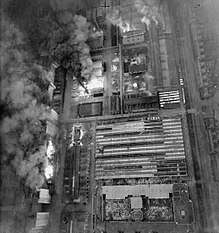
Pelly-Fry's aircraft, hit during the bomb run, had its starboard aileron shot off, making turns to port very difficult to do. While he struggled for control his course took him north. The trailing Bostons followed him right past the turn point. Soon they were trying to figure out what was going on. They were to clear the target area by flying north for a couple of miles, and then make a hard turn west for the coast. Instead they found themselves continuing north, toward Rotterdam. The north route to the coast was longer, and the port was heavily defended. Their Spitfire escorts would be waiting for them over Colijnsplaat. Eventually a number of the Bostons banked away and headed west.[57] The rest followed north to Rotterdam. Soon they were dodging the tall cranes of the shipping yards, a dangerous undertaking, but they all managed to get through.[58] The Mosquitos followed the Bostons in for their bomb run on the Strijp works. Patterson recalled,
In the distance I could see masses of Bostons whizzing about across the trees at low level to port. I came straight down to ground level. Now the Mosquitoes all split up and we all had to come home separately.[5]
The Mosquito crews were at liberty to choose their own route home to the north on this mission.[24]
Withdrawal
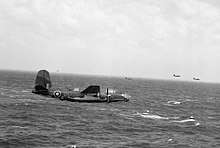
Much faster and with no defensive armament, it made no sense to tie the Mosquitos to the Bostons and Venturas. After initially flying north some turned to the west. Coming up behind the Bostons the Mosquitos could see them weaving and sliding. The Bostons were flying low and as fast as possible, with the hazards now increased by the addition of German fighters. They were lucky not to have any collisions. Said Boston pilot Jack Peppiatt "After a few minutes settling down it all went up with a bang as FW 190s appeared. Without doubt the next 20 minutes or so were full of action and not a little confusion. Some 10 or 20 aircraft were screaming along, full throttle in a loose mass. No one wanted to be at the back where the Focke-Wulfs were coming in to attack and wheeling away for another go."[57] The Bostons were soon joined by a number of Mosquitos, who looked to gain protection from their defensive firepower, but soon thought the better of it and sped past them. Thankfully the attacks in back were crimped for lack of altitude. Coming in from above they had to turn away early to the side, as there was no room below to dive through the group.
Except for the bomb run, a pilot never flew straight and level over enemy territory. The rear gunner served as the pilot's eyes in back. For a crew to make it home, the rear gunner had to see the enemy fighter, and as he closed in the gunner would wait, calling out to the pilot just as the fighter was preparing to fire. The gunner would fire his .303 machine guns, but accuracy was difficult with the airplane jerking about, and of a markedly secondary importance for the survival of the crew.[59][lower-alpha 3] In the running fight to the coast, pilots slid and weaved, keeping an ear out for the cry of "Jink!" Flak picked up again as they reached the coast and followed them out over the sea. One Boston was hit and crashed; as they pulled away larger caliber guns joined in, creating huge splashes with their shells in hopes of knocking an airplane down with the spray. This was frightening to the crews, many of whom thought the splashes were the result of their fellow aircraft falling, but they managed to all get clear.[61]
The Mosquitos scattered along different return routes.[5] Patterson decided it might be safer to avoid the planned route the Bostons were taking, as enemy fighters might have gathered over the west coast to intercept them. He headed north for the Zuider Zee, looking to hook around west past the gap at Den Helder. Fellow Mosquito pilot John O'Grady followed him. O'Grady was a young pilot from Canada who had trained under Patterson at an operational training unit. The two aircraft traveled north over the causeway low and fast, 20 feet over the water. As they approached the choke point where the southern tip of Texel approached Den Helder the Germans situated there put up a fierce barrage of flak. Patterson managed to fly through it unscathed, but O'Grady's aircraft was hit. They continued on, but a short way out over the North Sea Patterson's navigator called out "He's gone into the sea!" Patterson circled back, but all he could find was broiling water where his friend's aircraft had disappeared.[62]
German fighters had in fact gathered off the coast along the Bostons' route. Wing Commander Peter Dutton, the CO of 107 Squadron, was shot down 6 kilometers out from Katwijk aan Zee.[63] Two more from 107 were lost from fighter attacks over the water.[64] Another from 226 Squadron was lost off Scheveningen.[64]
Aftermath
Analysis
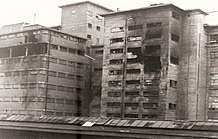
The Eindhoven Raid was a highly successful raid which took the German defenders by surprise. Low level navigation was excellent and around 83 per cent of the aircraft involved delivered 60 long tons (61 t) bombs with a high degree of accuracy and concentration. Reconnaissance photographs obtained later showed severe damage to the factory.[65][66] The losses suffered by 2 Group dictated that the operation type would not be repeated. Nevertheless, Operation Oyster is remembered as 2 Group’s most famous and successful operation of the war. Both factory complexes suffered significant damage and production had come to a stand still.[21]
For Frits Philips, the destruction came as a shock. Dutch nationalists like Philips had to walk a tightrope. He had to give the appearance of collaborating with his German occupiers, while providing a minimal effort in support of the German war industry. Philips had been hamstringing the plant's production for some time, but the overstated reports he had been sending to Germany had apparently found their way to the Air Ministry.[67] Facing the reality of the destruction the following morning, Philips' first concern was that his skilled workers would be removed to Germany.[68] He immediately set about putting his people to work clearing the debris, providing his German overseers with optimistic projections of the plant's return to function. He made certain the repairs proceeded in a deliberate manner. In May the following year the Gestapo put Philips in a concentration camp because he had failed to put an end to a strike. They kept him imprisoned for five months.[69] The RAF sent 10 Mosquitos to revisit the Philips plants on 30 March 1943 to check the recovery process.[70] It took six months to restore production.[71]
Subsequent events
Back in England, the returning aircraft were met at their airfields by waiting newspapermen, who swarmed about the crews and took pictures of the damaged airplanes. That night parties were held, and a concert given with household names from the world of radio entertainment. The next day the raid was celebrated in the press. The crews were all placed on a three-day leave.[72]
The Dutch continued to live under German occupation until Eindhoven was liberated on 18 September 1944. An intelligence inspection of the Philips plants after their liberation noted the passive resistance of the Philips leadership and the distrust of their German overseers. It asserted the most effective sabotage agency in action at Philips had in fact been the German system of allocation and control.[73]
Casualties

Aircrew losses were 62 men; fifteen aircraft were lost, including one in the sea and another crashed in England, a loss rate of 16 per cent; fifty-three bombers were damaged, 57 per cent of the force, seven seriously. Nine Venturas, four Bostons and a Mosquito were lost and 37 Venturas, 13 Bostons and three Mosquitoes were damaged. The Venturas had a 20 per cent loss rate and three crash-landings in England, an unsustainable loss rate.[74][75][21] Few of the losses and damages were caused by German fighters, the bombers proving difficult targets at low level; one Mosquito was intercepted by a FW 190 as it approached Eindhoven and abandoned its bombing run after evading the FW for fifteen minutes, the FW gave up the chase near Flushing. A minimum of 31 aircraft had bird strikes, some hit trees and several Venturas probably hit houses when bombing through smoke; light flak damaged some aircraft and possibly shot down others.[76] The Group had to stand down for ten days while their aircraft were repaired and losses replaced.[77] A B-17 and one B-24 were lost in the two diversionary raids, along with one of the escorting Spitfires; a FW 190 had also been shot down.[78]
References
Notes
- ↑ The first Mosquitos built were rated with a level flight top speed of 392 mph, besting the Spitfire Mk V, which topped out at 372 mph. The Focke-Wulf 190A had a level flight top speed of 396 mph, but each aircraft did vary slightly based on how it was tuned.
- ↑ The Germans did not synchronize the engines on their two engine aircraft, and subsequently they would give off an angry throbbing sound. The British did, reducing the noise and giving them a distinctive hum, which the Dutch soon came to recognize.[49]
- ↑ The Eighth Air Force flew in tight formations, maintaining a steady gun platform and using the defensive fire of the group to defeat the attackers.[60]
Citations
- 1 2 Rijken, Schepers & Thorning 2014, pp. 5–6.
- 1 2 3 4 Ashworth 1995, p. 69.
- 1 2 3 Bowman 2014, p. 189.
- ↑ Rijken, Schepers & Thorning 2014, p. 9.
- 1 2 3 4 "Low Level Daylight Attack on the Philips plant, Holland". WW2 Today. Archived from the original on 13 May 2018. Retrieved 27 April 2018.
- 1 2 Rijken, Schepers & Thorning 2014, pp. 22–23.
- ↑ Bowman 2014.
- ↑ Rijken, Schepers & Thorning 2014, p. 27.
- 1 2 3 Rijken, Schepers & Thorning 2014, p. 22.
- 1 2 3 Rijken, Schepers & Thorning 2014, p. 26.
- ↑ Rijken, Schepers & Thorning 2014, pp. 158–159.
- ↑ Rijken, Schepers & Thorning 2014, p. 163.
- ↑ Bowman 2014, p. 191.
- 1 2 Rijken, Schepers & Thorning 2014, p. 23.
- ↑ "Private Papers of Group Captain J E Pelly-Fry, DSO". Imperial War Museum. Archived from the original on 10 May 2018. Retrieved 1 May 2018.
- 1 2 3 Rijken, Schepers & Thorning 2014, p. 44.
- ↑ Rijken, Schepers & Thorning 2014, p. 154.
- ↑ Rijken, Schepers & Thorning 2014, pp. 23, 22.
- 1 2 Rijken, Schepers & Thorning 2014, p. 28.
- ↑ Ashworth 1995, pp. 69–71.
- 1 2 3 4 5 Ashworth 1995, p. 71.
- 1 2 Rijken, Schepers & Thorning 2014, p. 61.
- ↑ Rijken, Schepers & Thorning 2014, pp. 23, 57.
- 1 2 Rijken, Schepers & Thorning 2014, p. 160.
- ↑ Rijken, Schepers & Thorning 2014, p. 129.
- 1 2 3 4 Rijken, Schepers & Thorning 2014, p. 32.
- ↑ Bowman 2014, p. 187.
- ↑ Rijken, Schepers & Thorning 2014, pp. 30, 163.
- 1 2 "VIII Bomber Command 24: 6 December 1942". American Air Museum in Britain. Archived from the original on 22 September 2017. Retrieved 30 April 2018.
- ↑ Rijken, Schepers & Thorning 2014, p. 183.
- ↑ Rijken, Schepers & Thorning 2014, p. 182.
- ↑ Rijken, Schepers & Thorning 2014, p. 30.
- ↑ Rijken, Schepers & Thorning 2014, p. 149.
- ↑ Rijken, Schepers & Thorning 2014, p. 31.
- ↑ Rijken, Schepers & Thorning 2014, p. 33.
- 1 2 Rijken, Schepers & Thorning 2014, p. 34.
- ↑ Bowman 2005, p. 313.
- ↑ Bowman 2005, p. 315.
- ↑ Rijken, Schepers & Thorning 2014, pp. 34–35.
- ↑ Bowman 2014, p. 196.
- ↑ Rijken, Schepers & Thorning 2014, p. 37.
- ↑ Bowman 2005, p. 308.
- 1 2 Rijken, Schepers & Thorning 2014, p. 39.
- ↑ Bowyer 2001, p. 64.
- ↑ Rijken, Schepers & Thorning 2014, p. 38.
- ↑ Bowman 2005, p. 312.
- ↑ Rijken, Schepers & Thorning 2014, p. 40.
- ↑ Rijken, Schepers & Thorning 2014, p. 42.
- ↑ Rijken, Schepers & Thorning 2014, pp. 109–110.
- ↑ Rijken, Schepers & Thorning 2014, p. 112.
- ↑ Rijken, Schepers & Thorning 2014, p. 49.
- ↑ Rijken, Schepers & Thorning 2014, p. 47.
- ↑ Rijken, Schepers & Thorning 2014, p. 62.
- ↑ Rijken, Schepers & Thorning 2014, p. 60.
- ↑ Rijken, Schepers & Thorning 2014, p. 48.
- ↑ Rijken, Schepers & Thorning 2014, pp. 63, 62.
- 1 2 Rijken, Schepers & Thorning 2014, p. 67.
- ↑ Rijken, Schepers & Thorning 2014, pp. 65–67.
- ↑ Middlebrook 1974, p. 48.
- ↑ Paridon, Seth (18 October 2017). "The Eighth Air Force vs The Luftwaffe". The National WWII Museum. Archived from the original on 14 May 2018. Retrieved 8 May 2018.
- ↑ Bowman 2014, p. 188.
- ↑ Rijken, Schepers & Thorning 2014, p. 70.
- ↑ Rijken, Schepers & Thorning 2014, p. 68.
- 1 2 Rijken, Schepers & Thorning 2014, p. 69.
- ↑ Rijken, Schepers & Thorning 2014, p. 165.
- ↑ Webster & Frankland 2006, p. 440.
- ↑ Rijken, Schepers & Thorning 2014, p. 98.
- ↑ Rijken, Schepers & Thorning 2014, p. 101.
- ↑ "Frits Philips celebrates 100th birthday", Philips Company, 2005
- ↑ "Campaign report of the RAF, 30 March 1943". Back to Normandy. Retrieved 6 May 2018.
- ↑ Rijken, Schepers & Thorning 2014, p. 116.
- ↑ Rijken, Schepers & Thorning 2014, p. 76.
- ↑ Watt, Robert (26 September 1944). "Inspection of Philips Works at Eindhoven, September 23-26, 1944" (PDF). Combined Intelligence Objectives Sub-committee, SHAEF. Retrieved 6 May 2018.
- ↑ Terraine 1998, p. 498.
- ↑ Webster & Frankland 2006, pp. 440–441.
- ↑ Webster & Frankland 2006, p. 441.
- ↑ Rijken, Schepers & Thorning 2014, p. 64.
- ↑ Rijken, Schepers & Thorning 2014, pp. 32, 133.
Bibliography
- Ashworth, Chris (1995). RAF Bomber Command 1936–1968. Somerset, UK: Haynes. ISBN 978-1-85260-308-3.
- Bowman, Martin (2014). Voices in Flight: Daylight Bombing Operations 1939–1942. Barnsley, South Yorkshire: Pen & Sword Aviation. ISBN 978-1-78383-177-7.
- Bowman, Martin (2005). The Reich Intruders: RAF Light Bomber Raids in World War II. Barnsley, South Yorkshire: Pen & Sword Aviation. ISBN 9781844153336.
- Bowyer, Chaz (2001). Bomber Barons. Barnsley: Leo Cooper. ISBN 978-0-85052-802-2.
- Middlebrook, Martin (1974) [1973]. The Nuremberg Raid: The Worst Night of the War March 30–31 1944. New York: William Morrow & Co. ISBN 068802873X.
- Terraine, J. (1998) [1985]. The Right of the Line: The Royal Air Force in the European War 1939–1945 (Wordsworth ed.). London: Hodder and Stoughton. ISBN 978-1-85326-683-6.
- Rijken, Kees; Schepers, Paul; Thorning, Arthur (2014). Operation Oyster: The Daring Low Level Attack on the Philips Radio Works (ebook ed.). Barnsley: Pen & Sword. ISBN 978-1-4738-3907-6.
- Webster, Charles; Frankland, Noble (2006) [1961]. The Strategic Air Offensive Against Germany 1939–1945. History of the Second World War United Kingdom Military Series. I. Preparation parts 1, 2 and 3 (Naval & Military Press, Uckfield ed.). London: HMSO. ISBN 978-1-84574-347-5.
Further reading
- Franks, Norman (2016). Fighter Command's Air War 1941. South Yorkshire Pen & Sword Books. ISBN 978-1-4738-4722-4.
- Murray, Williamson (1989) [1983]. Strategy for Defeat: the Luftwaffe, 1933–1945. Maxwell Air Force Base, AL: Air University Press. ISBN 978-0-933852-45-7.